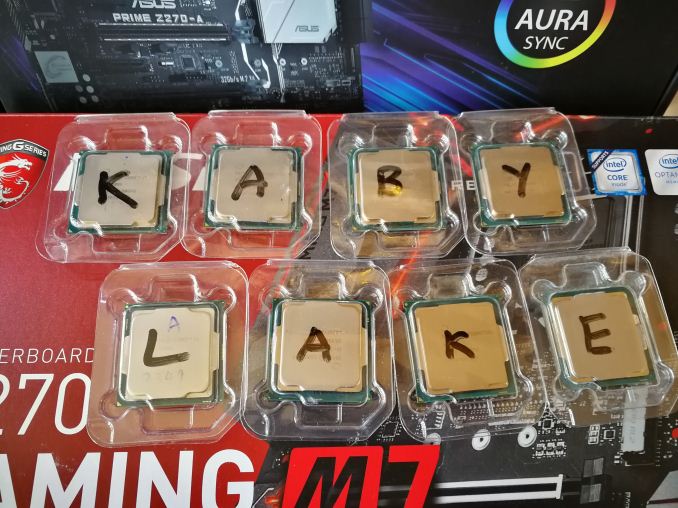The Intel Core i7-7700K (91W) Review: The New Out-of-the-box Performance Champion
by Ian Cutress on January 3, 2017 12:02 PM ESTThe New Champion
Given that Intel has no competition, it is perhaps easy to roll out a new mainstream performance champion – all they have to do is have more stringent binning techniques (like perhaps AMD with the FX-9000 series) and a few processors with a higher frequency could pop-out. The danger here is that Intel always sells a lot of its top performer – millions. If you have to dump 100 processors to find one that fits the mold of the top SKU, you either have to charge lots for it or reduce the rules. The only way to get that mix of yield and viability is by improving how the CPU is made. This is what the ‘optimization’ in Kaby Lake is for.
The Core i7-7700K sits at the top of the stack, and performs like it. A number of enthusiasts complained when they launched the Skylake Core i7-6700K with a 4.0/4.2 GHz rating, as this was below the 4.0/4.4 GHz rating of the older Core i7-4790K. At this level, 200-400 MHz has been roughly the difference of a generational IPC upgrade, so users ended up with similar performing chips and the difference was more in the overclocking. However, given the Core i7-7700K comes out of the box with a 4.2/4.5 GHz arrangement, and support for Speed Shift v2, it handily mops the floor with the Devil’s Canyon part, resigning it to history.
In most of our benchmarks, the results are clear: a stock Core i7-7700K beat our overclocked Core i7-4790K in practically every CPU-based test (Our GPU tests showed little change). When overclocked, the i7-7700K just pushed out a bigger lead for only a few more watts. Technically one could argue that because this part and the i7-6700K are equal in IPC, a similar overclock with the i7-6700K achieves the same performance. But the crucial matter here is how lucky a user is with the silicon lottery – based on our testing, the Core i7-7700K CPUs tend to overclock rather nicely (although +300 MHz isn’t that much in the grand scheme of things).
As with previous high-end mainstream (if that sounds like an oxymoron, it is) Core i7 parts, Intel has put a list price of $303 on 1k tray units, which means that at retail we should see it nearer $330 to $350. As far as we can tell, this won’t get a stock cooler, and anyway we’d recommend something else anyway given the recent performance of Intel stock coolers. We can hope that we won’t see the blatant price gouging we saw when the Skylake parts were launched, where it took several months to bring the prices down to MSRP due to stock allocations.
The Core i7-7700K should be available from January 5th in most major markets.
It’s the new mainstream performance king, if CPU performance is your thing.
As part of our Kaby Lake coverage, we have some other awesome reviews to check out.
Intel Launches 7th Generation Kaby Lake (Overview and Core Improvements)
The Intel Core i7-7700K Review: The New Out-of-the-box Performance Champion
The Intel Core i5-7600K Review: The More Amenable Mainstream Performer
The Intel Core i3-7350K Review: When a Core i3 Nearly Matches the Core i7-2600K
Upcoming (we’re at CES and didn’t have time to finish these yet):
Calculating Generational IPC Changes from Sandy Bridge to Kaby Lake
Intel Core i7-7700K, i5-7600K and i3-7350K Overclocking: Hitting 5.0 GHz on AIR
Intel Launches 200-Series Chipset Breakdown: Z270, H270, B250, Q250, C232
Intel Z270 Motherboard Preview: A Quick Look at 80+ Motherboards











125 Comments
View All Comments
silverblue - Wednesday, January 4, 2017 - link
To be fair, even if Intel can't go any further with IPC on this architecture, extra clock speed for no extra power isn't such a bad thing. This was the optimisation step of the cadence anyway, so I don't get the hate.Lolimaster - Wednesday, January 4, 2017 - link
Normally the chips should be called 6780K or 6790K, intel forgot that you can increase the SKU number when models with higher clocks appears.Now it's the "new 7th gen".
silverblue - Thursday, January 5, 2017 - link
I agree about the naming, though perhaps they just wanted to set their newer models apart. A 6710K (or, indeed, a 6780K) wouldn't confuse most of us.Manch - Thursday, January 5, 2017 - link
Its basically the same as NVidia and AMD rebadging GPU's. Now Intel is doing the same thing.silverblue - Thursday, January 5, 2017 - link
A true rebrand would do little if nothing at all for a higher number; Intel have at least made tweaks.fanofanand - Thursday, January 26, 2017 - link
Not true, with nearly every re-badge they have either increased VRAM capacity or speed, and/or increased clocks on the shaders. Re-badges suck but they have almost always offered at least tiny improvements, much like Kaby Lake.Thatguy97 - Friday, January 6, 2017 - link
The hate is that this is a complacent IntelLolimaster - Wednesday, January 4, 2017 - link
There's 0.00% IPC improvement.tvdang7 - Wednesday, January 4, 2017 - link
Why didn't you compare the performance gap between generations like you guys do for the other reviews.lopri - Wednesday, January 4, 2017 - link
AVX Offset? Why isn't that a cheat?